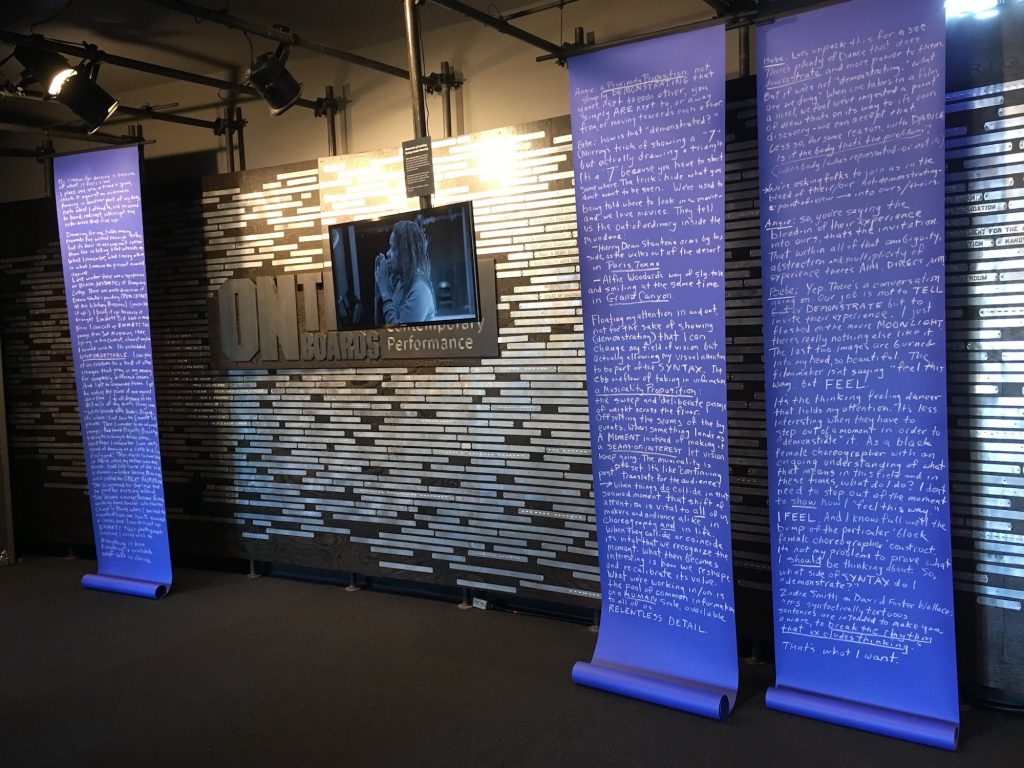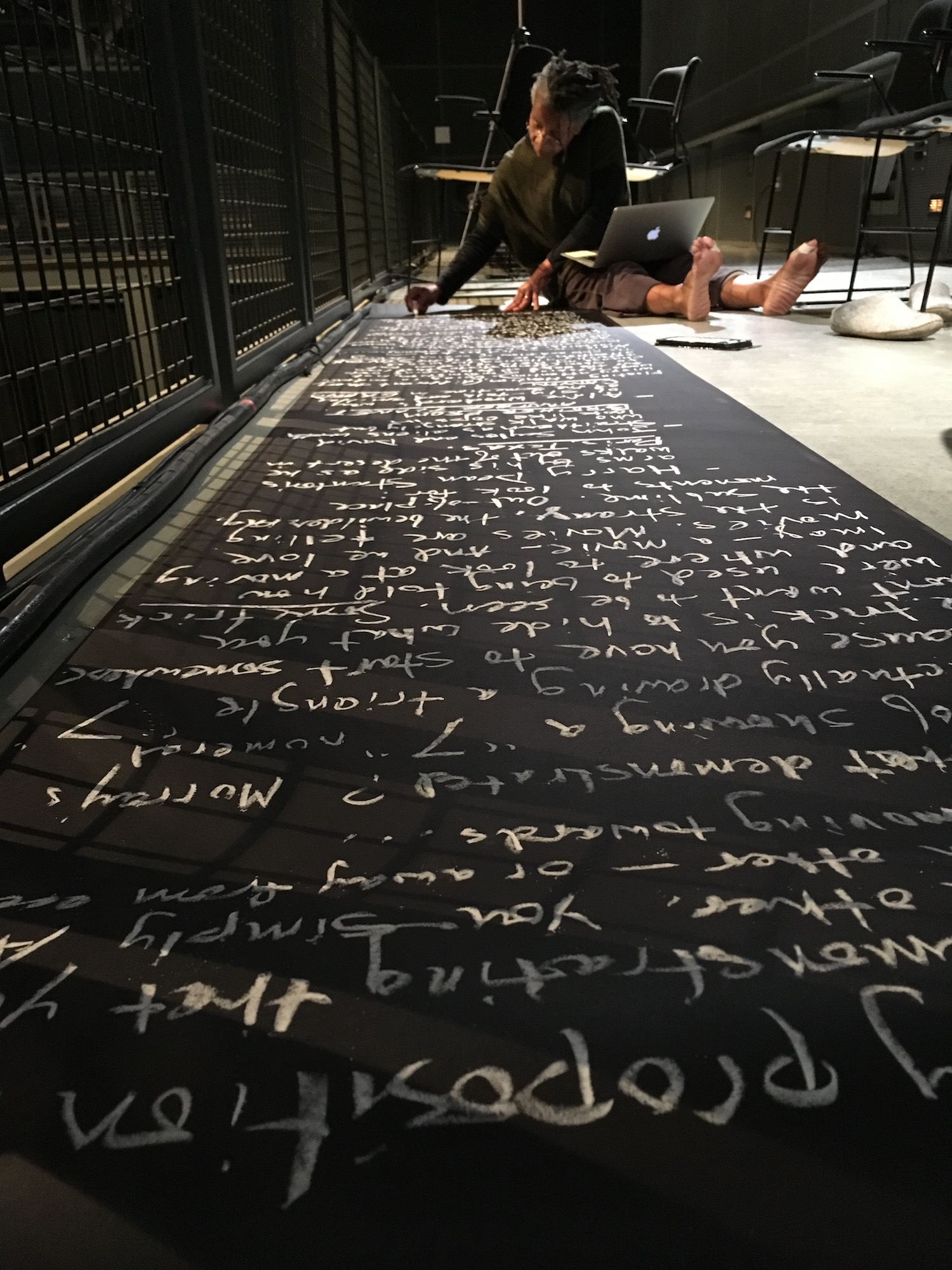
Integral to the presentation of In A Rhythm was an installation in each venue’s lobby.
This installation included a 14-minute video by Lily Skove, Moments of Looking: Seeing Inside Dancing. Lily had documented rehearsals at several of our creative residencies—as a recorder and translator of the days’ events, she trained her eye on the alchemical exchange between the artists in the room. She focused on how the dancers see each other inside the piece—their gaze towards one another and their exchange with the audience. The video is a distillation of what she saw.
In addition, three long scrolls of text by Bebe Miller were hung, which audiences read before and after the performance. The text of the scrolls follows.
My reason for dancing is because of what it feels like. I place one arm in time and space, check it against an awareness forming in another part of my body, note what I attend to, and proceed to bend, redirect, interrupt the references that rise up.
Dancing for me holds many moments I’ve walked through before, but it’s their rearrangement rather than the retelling that most interests me. What I remember, what I carry with me, is what I measure the present moment against. Last winter there was a symposium on Black Aesthetics at Hampshire College. There was much discussion of Dana Schutz’s painting OPEN CASKET (You can look it up.) I bring it up because it brought Emmett Till back in mind. Now, I can call up Emmett Till’s image from Jet Magazine, lying in his casket, almost anytime I would wish to. It’s embedded, UNFORGETTABLE. I can place it in relation to a host of other images that play in my memory for completely different reasons. And I get to organize them, I get to notice the power of one against another. I get to go all dreamy in the details of my aunt’s living room – white brocade sofa with plastic slipcovers, Reader’s Digest Condensed Books in the bookcase – where I first saw the Emmett Till photo, feeling the pull of my private memory. I get to wander in an adjacent image of nursery school vintage, the Red Hook projects in Brooklyn where I grew up, then the walk to the subway on the way to dance classes, and then remember that I was good at dancing as a little kid, at improvising about clouds, I was really good! And I get to follow that path of recall, travel to summer camp in Maine where I learned the names of trees, where my mother was the nurse, my mother who left Mississippi at age 20 before her leaving was called the GREAT MIGRATION, who left for New York to be a domestic, who so impressed her employer that he paid for her to enroll in nursing school, becoming the nurse who became friends with my teacher in dance class, who was the director of the summer camp in Maine where I learned the names of trees, how to build a fire, and how to ride a horse and swamp a canoe, and I can still call up EMMETT TILL’S photograph anytime I would wish to.
Everything is here. Everything is available. What’s left is choice.
Angie: Proximity proposition: not simply demonstrating that you’re next to each other; you simply ARE next to each other or away from each other, or moving towards.
How is that “demonstrated?” (Murray’s trick of showing a “7” but actually drawing a triangle. “7” because you have to start somewhere. The trick is to hide what you don’t want to be seen. Some trick. we’re used to being told how and where to look at a moving image in a movie – and we love movies. Movies are telling us the strange, _________out of place moments to look for:
- Harry Dean Stanton’s arms by his side as he walks out of the desert in Paris, Texas.
- John Sayles and David Straitharn’s aliens who walk strangely but look like cops in Brother from Another Planet.
- Alfre Woodard’s way of sly-talk and smiling at the same time in Grand Canyon.
Floating attention (different from wispy). Going in and out, ways of taking in not for the sake of telescoping out and showing (demonstrating) that I can change my field but actually allowing the visual attention to be part of the SYNTAX.
Bebe: the ebb and flow of seeing and taking in.
Angie: for me that has to do with meaning. Ebb 7 flow of meaning making.
Musicality proposition:
- the sweep of the floor, the deliberate passage of weight.
The offsetting the seams of the big events. When it lands as A THING, instead of making it a seam, the vision keeps going, the musicality is offset.
Angie: “What is it I’m reminding myself—the deliberate passage of weight.”
Bebe: it’s like continuing past. Translating for audience: when things do collide in that seamed moment, that shift of attention is vital to us, not only as audience and makers and audience but also in life – when they do collide or coincide, that we recognize those things. I think we’re talking on one about how we make this, but also how this can be seen and viewed, and how it relates to everything else we see and view. That circling of common information on a human scale is really what we’re working in.
Relentless detail.
Let’s unpack that for a sec. There’s plenty of dance that does demonstrate, and more power to them, they have their own wing in the edifice. But if we’re not demonstrating, what are we doing? And this is often where a misunderstanding of dance takes place: where we read a particular novel, poetry, nonfiction, filmic, cinematic information that we feel that we’ve ingested a point of view that’s on its way to its own discovery, we can accept that. often in dance we somehow can’t accept that. We can talk at length: is it the body? Is it because it’s the body in this American western society…, what is our tradition in this form? Regardless there is a kind of a…what we’re asking for them to join us in the potential of the non-demonstration of their (our) point of view to bleed into ours (theirs’s). There’s a conversation going on. That our job is not to TELL but to invite their experience. Which of course means walking away with their own experience. Sounds like a free-for-all? NOT TRUE. There’s a direction, an aim… I hope you catch what I’m saying! Language is insufficient.
Angie: so, you’re saying: the bleed-in of their experience into ours, that invites their experience. I appreciate the teasing out that there’s not just a free-for-all interpretation, that somehow within that ambiguity/abstraction/ multiplicity of experience there is Aim, Directness. And I can make a very quick and confident correlation to the movement itself with that: that we are interested in the embodiment of that as well as the landed experience for the audience. That in the dancing itself there’s that [whoosh!] sharpness/ clarity of focus/ clarity of action that boldness of touch or relationship inside the soup of the unknown as well. Trying to keep those going together is something that’s interesting to us, the multiplicity of that – together.
Bebe: of course, as you say ‘multiplicity’ of course I think of Tere O’Connor! It would be fun to bring up the people who are also in the room, who’re in my head (Pina!!). I flashed on MOONLIGHT…. Whether or not it’s a perfect film there’s nothing else like it. The last two images are BURNED into my head, so beautiful. The filmmaker is not saying ‘feel this way’ but “FEEL.”
It’s the thinking feeling dancer that holds our attention. I’m less interested in, I’m not looking at expression – or demonstration – of a particular sort. It’s less interesting when they have to step out of the moment in order to demonstrate it. As a black female choreographer with an ongoing understanding of what that means in these times, what do I do? I don’t need to step out of the moment to show how to “feel this way.” I FEEL. And I know full well that in the context of these times and this field the bump of my particular ‘black female choreographer’ construct. And so, is my responsibility to myself? It’s not my problem to prove what I should be thinking about to other people. Hey. So, what side of syntax do I “demonstrate?”
Zadie Smith on David Foster Wallace: “his ’syntactically tortuous’ sentences are intended to make you aware, to break the rhythm that excludes thinking.”
That’s what I want.
